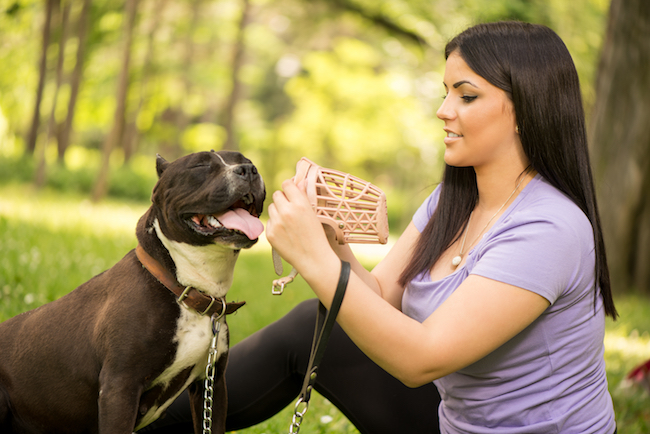
The word “muzzle” has a bad connotation because of how some pet owners have misused them in the past. However, when applied by responsible and caring individuals the muzzle is a helpful tool used to work with dogs, as well as protect them from any accidents or mishaps they could be liable for. Here are some relevant questions to think about when you are considering if your dog needs a muzzle and what kind would be the best fit for him.
Puzzles About Muzzles
When would a dog need a muzzle? In certain countries, some dog breeds are restricted from going out in public without a muzzle. For health reasons, muzzles are used to keep dogs from licking a sensitive area of their body (such as a wound in the process of healing), when an Elizabethan collar is unavailable. Muzzles might also be donned if the owner is visiting a new place that might have poisonous plants, or objects around that your curious dog could swallow and be damaged by. If you are going to a group-training course and socializing your pup, muzzling is a good risk-free way to introduce your dog to other animals. People also feel safer when a strange dog is wearing a muzzle, which is especially helpful when a dog is traveling with their owner in public transportation, or is going for a walk in a highly populated area.
If you have a dog who is in the midst of training, may be unreliable and likely to bite, and you have to take him to a crowded public place or a stressful location (like the vet), then it would be wise to wear a muzzle. It might seem harsh to you at first, but think if your pup got riled up or anxious, and nipped at someone, you could be sued or the dog put down. It is not worth the risk. Muzzles are NOT a long-term solution for pups that have a tendency to nip, and training should always be an important aspect of your dog-rearing, especially if your dog is an aggressive one. Muzzles are simply a backup safeguard that help protect your dog from putting himself into a sticky situation.
When would a dog not need a muzzle? If the pup has problems chewing on shoes, plastic objects, or is gnawing on furniture, then a muzzle is not the right way to correct the behavior. This will not show him that the action of chewing it wrong, and it could potentially cause frustrations leading to other bad behaviors. Instead, work on training your pooch to chew on the right things, by providing chew toys, interrupting him when he chomps on the wrong thing, and spraying taste deterrents wherever you don’t want tooth marks.
What kind of muzzle should be used? There are many kinds of dog muzzles from plastic baskets, to cage metal, to leather and vinyl “breathable” muzzles. Some are designed for use at the groomers, while others allow the dog to pant, breathe easily and even bark or growl. The kind of muzzle will depend on what sort of outing you and your dog are going on, and which muzzle will give him the most freedom, while taking whatever necessary precautions for the issue that required the muzzle in the first place.
What should someone avoid when using a muzzle? Stay away from using a muzzle that may not fit exactly, as this might restrict the dog’s breathing, cause chaffing along his jaw line, or make the pup overheat (i.e., not be able to pant.) This is most common with tight muzzles made of mesh material. A muzzle should only be left on for short spurts of time (no longer than 20-30 minutes) or this might incite the dog’s frustration and cause him to act out.

